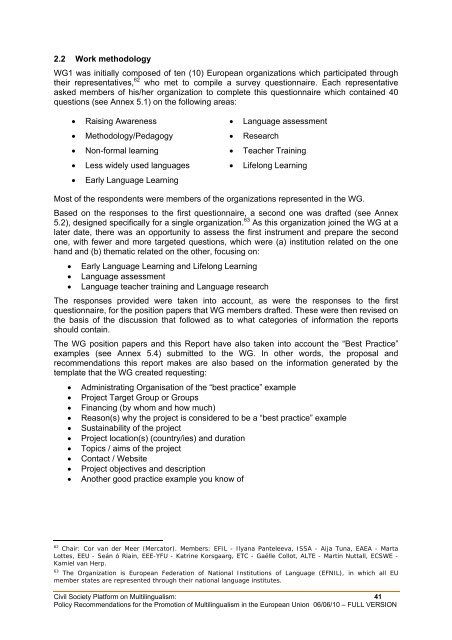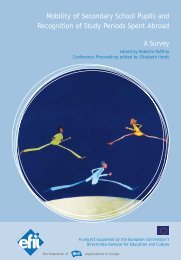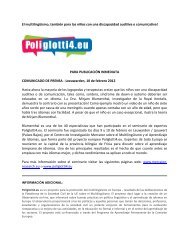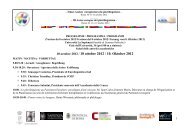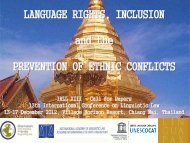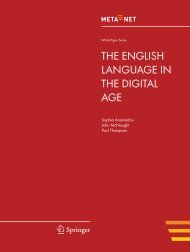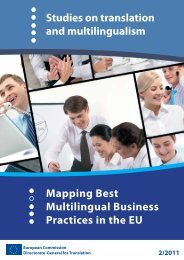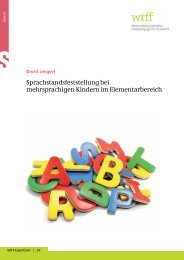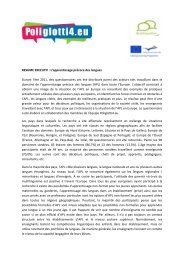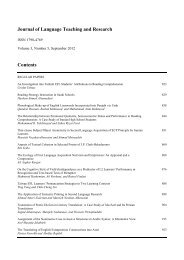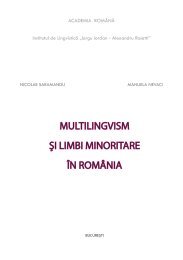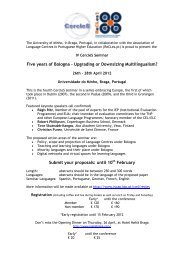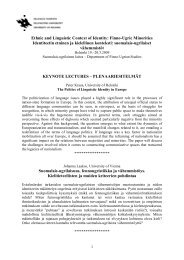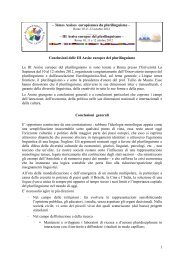2 Conceptual framework and work methodology2.1 The notions of multilingualism and educationThe Work Group agrees that ‘multilingualism’ and other related terms, such as ‘linguisticdiversity’ and ‘plurilingualism’, are neither apolitical nor ideologically neutral notions. There isfurther agreement about the fact that though these terms are sometimes usedinterchangeably, they should be distinguished from one another. Multilingualism is an allencompassingterm, which may be used for individuals or groups of people who can use anumber of languages, or for communities where several languages co-exist –regardless ofwhether this state of affairs is officially recognized or not. Moreover, the term may be used todescribe a school curriculum offering several languages to pupils and encouraging them tolearn more than one foreign language. It may also be used –and it often is- when one istaking a position in favour of reducing the dominant position of English inside and outsideEurope. In other words, though the term is equivocal, it does mark a negative position towardmonolingualism and its counterpart: monoculturalism.WG1 believes that monolingual and monocultural practices are bound to have negativeimplications for <strong>European</strong> integration since the condition for the formation of a united Europeis that all member states participate equally in its making and that the national interests, thecultural and linguistic rights of each state are not questioned.However, from the point of view of language education, with which WG1 is cruciallyconcerned, it is also important to point out that the group supports the plurilingual approachto education for the development of multilingualism. The group’s understanding ofplurilingualism agrees with the Common <strong>European</strong> Framework of Reference for Languages(CEFR: 4) as it explains that the plurilingual approach emphasises the fact that:“…as an individual person's experience of language in its cultural contexts expands,from the language of the home to that of society at large and then to the languages ofother peoples (whether learnt at school or college, or by direct experience), he or shedoes not keep these languages and cultures in strictly separated mentalcompartments, but rather builds up a communicative competence to which allknowledge and experience of language contributes and in which languagesinterrelate and interact.”Approaches to language education, i.e., to teaching and learning, conducive to multilingualcitizenry in Europe have been at the heart of the discussions of WG1. However, in makingthis statement it is important to assert that the term education has been used broadly used tocover formal education (public, state or private), but also informal education. It also coversteaching (in a classroom context or from a distance), as well as learning: formal, non-formaland informal. It has covered cultural activities and awareness raising which may occurthrough social practices and organized projects.When referring to education, people generally tend to think of teaching rather than learning.In as far as learning is concerned, it seems that most people are familiar with formal learningsituations, i.e. those provided in institutional contexts concerned with the learning processrather than the outcome of teaching or those provided through computer or web-basedprogrammes (e.g. self-access learning and distance learning programmes). Fewer peopleare familiar with non-formal learning contexts, i.e. learning which is intentional from thelearner’s perspective, but not provided by educational or training institutions. This, like formallearning, is also practiced as a structured activity –structured in terms of learning objectives,learning time or learning support. Finally, the kind of learning that we are all familiar with butrarely think of as social practice with remarkable results is non-intentional informal learning.Such learning is the product of daily life activities related to work, social or family or leisure. Itis not structured (in terms of learning objectives, learning time or learning support) andtypically does not lead to certification. Our WG was interested in all these educationalopportunities.Civil Society Platform on Multilingualism: 40Policy Recommendations for the Promotion of Multilingualism in the <strong>European</strong> Union 06/06/10 – <strong>FULL</strong> <strong>VERSION</strong>
2.2 Work methodologyWG1 was initially composed of ten (10) <strong>European</strong> organizations which participated throughtheir representatives, 62 who met to compile a survey questionnaire. Each representativeasked members of his/her organization to complete this questionnaire which contained 40questions (see Annex 5.1) on the following areas:Raising AwarenessLanguage assessmentMethodology/PedagogyResearchNon-formal learningTeacher TrainingLess widely used languagesLifelong LearningEarly Language LearningMost of the respondents were members of the organizations represented in the WG.Based on the responses to the first questionnaire, a second one was drafted (see Annex5.2), designed specifically for a single organization. 63 As this organization joined the WG at alater date, there was an opportunity to assess the first instrument and prepare the secondone, with fewer and more targeted questions, which were (a) institution related on the onehand and (b) thematic related on the other, focusing on: Early Language Learning and Lifelong Learning Language assessment Language teacher training and Language researchThe responses provided were taken into account, as were the responses to the firstquestionnaire, for the position papers that WG members drafted. These were then revised onthe basis of the discussion that followed as to what categories of information the reportsshould contain.The WG position papers and this Report have also taken into account the “Best Practice”examples (see Annex 5.4) submitted to the WG. In other words, the proposal andrecommendations this report makes are also based on the information generated by thetemplate that the WG created requesting:Administrating Organisation of the “best practice” exampleProject Target Group or GroupsFinancing (by whom and how much)Reason(s) why the project is considered to be a “best practice” exampleSustainability of the projectProject location(s) (country/ies) and durationTopics / aims of the projectContact / WebsiteProject objectives and descriptionAnother good practice example you know of62 Chair: Cor van der Meer (Mercator). Members: EFIL - Ilyana Panteleeva, ISSA - Aija Tuna, EAEA - MartaLottes, EEU - Seán ó Riain, EEE-YFU - Katrine Korsgaarg, ETC - Gaëlle Collot, ALTE - Martin Nuttall, ECSWE -Kamiel van Herp.63 The Organization is <strong>European</strong> Federation of National Institutions of Language (EFNIL), in which all EUmember states are represented through their national language institutes.Civil Society Platform on Multilingualism: 41Policy Recommendations for the Promotion of Multilingualism in the <strong>European</strong> Union 06/06/10 – <strong>FULL</strong> <strong>VERSION</strong>


